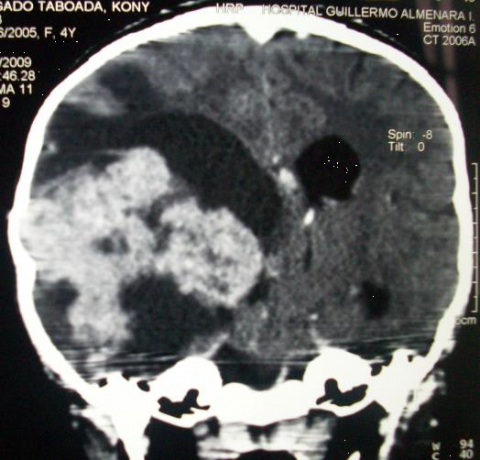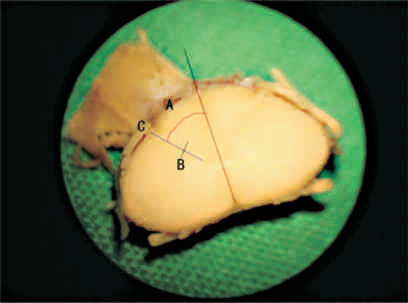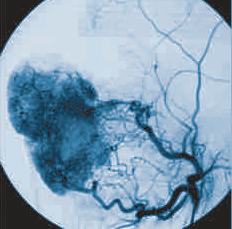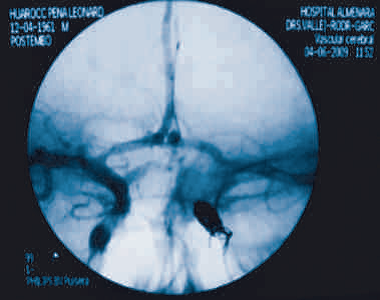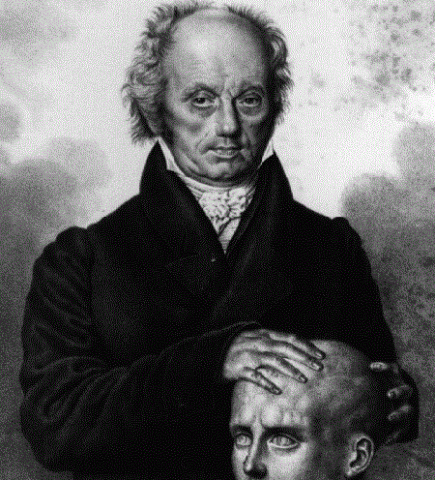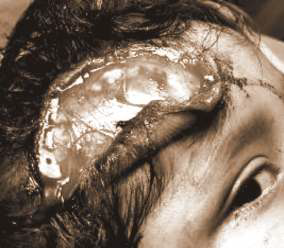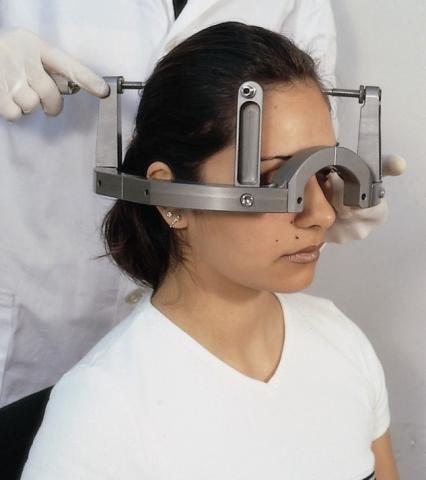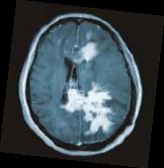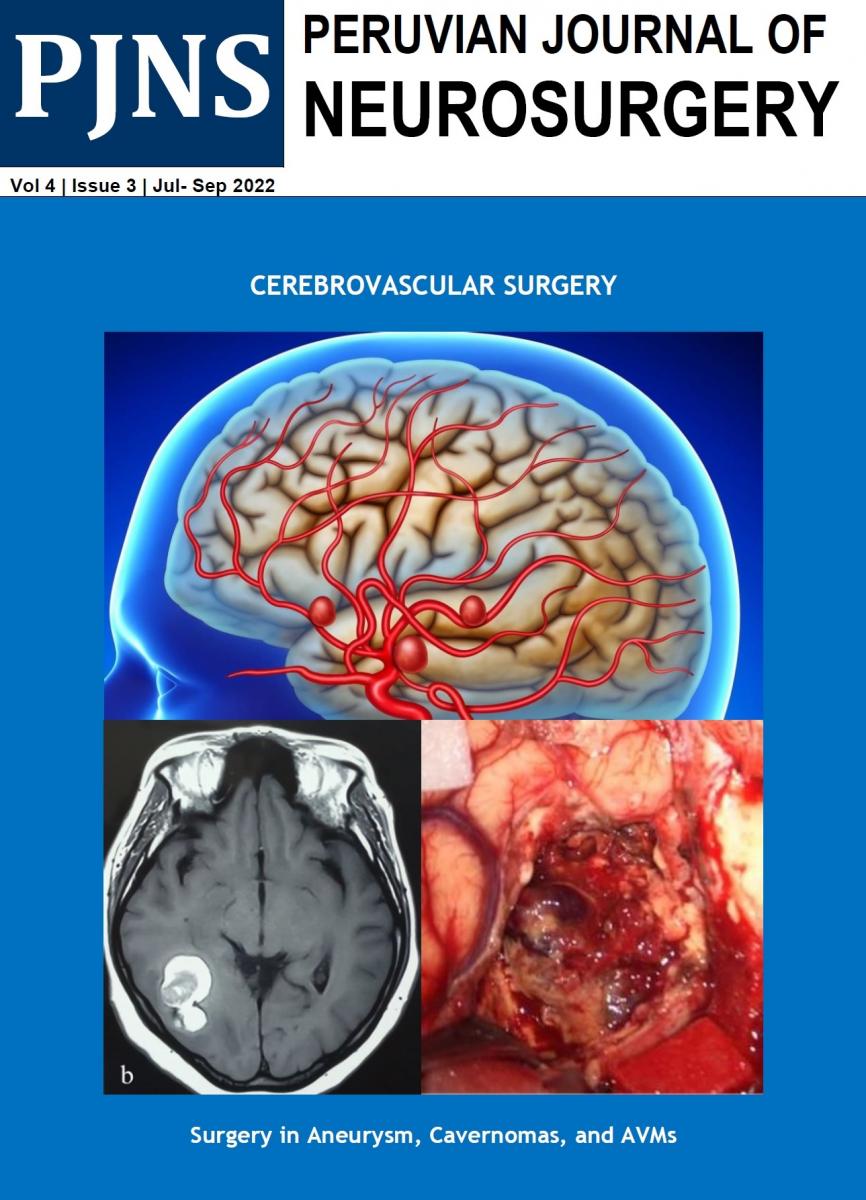Usted está aquí
Peruvian Journal of Neurosurgery
Intraventricular astroblastoma: Case report
ABSTRACT
Astroblastoma is a tumor of the glial lineage of unknown origin and uncertain prognosis. Represents 0,4 - 2,8% of brain gliomas, which generally presents in youth people as an hemispheric well defined tumor, often associated with a cystic component, being extremely rare intraventricular location. The author reports the case of a patient of 4 years old girl with intraventricular astroblastoma and a review of the literature. Complete resection was demonstrated in early postoperative CT. The patient began disease since three month before the surgery with persistent headache, nausea and vomiting. She suffer cranial trauma and the indicated brain scan showed well-defined giant intraventricular tumor, at the right temporal horn with heterogeneously contrast enhancement. The patient was not treated favorably adjuvant after surgery without evidence of tumor recurrence 06 months after surgery. The histological features including nuclear pleomorphism, presence of perivascular pseudorosettes astroblastic typical and perivascular hyalinization. Have distinguished two types of astroblastoma according to histological grade; however, the prognosis in cases is not directly related to the histological type. Surgical resection remains an important prognostic factor.
Percutaneous Rhizotomy Gasserian ganglion with ball for treatment of trigeminal neuralgia
ABSTRACT
We present four patients with trigeminal neuralgia treated by percutaneous rhizotomy of the Gasserian ganglion with balloon. The procedure was performed with fluoroscopic assistance with sedo analgesia without intubation. All patients were females. The sector most affected was V2 (50%). We obtained the three forms of balloon described (pear, hourglass, oval). In the four patients had immediate pain relief in the immediate postoperative. The procedure was ambulatory, except in one patient who was bedridden, in very poor general state of malnutrition, caused by the pain that prevented her from eating. She was discharged on the third day, eating well and walking around. One of the patients had mild dysesthesia that disappeared at the week of evolution. In all cases there was slight hypoesthesia in the hemifacie treated with progressive improvement and described as not significant for any patient.
Intraoperative rapid diagnosis by SQUASH smears in central nervous system lesions. An early institutional experience.
ABSTRACT
Objective: Intra-operative cytological diagnosis of the CNS lesions helps the neurosurgeon to decide about the extent of resection particularly in eloquent areas. The squash or crush preparation of the available tiny tumor tissue at the start of the resection is a time saving and lead to better decision on further plan of surgery.
Material and methods - We have prospectively studied the accuracy of this technique at our institute. During the period of last two years we have operated 118 CNS mass lesions including cranial and spinal. All cases were subjected to squash diagnosis and later compared with paraffin sections.
Results - Out of total 118, cranial lesions were 105 and spinal were 13. Males outnumbered in frequency (77 cases, 65.2%) while the females comprised 41 cases (34.7%). Most (59.2%) of the patients were from 20 to 50 years of age. The cerebral hemisphere including all lobes had the largest number of cases (49 cases, 41.5%). Among them glial tumors form the major group (34 cases, 28.8%). Meningiomas were the next main group (18 cases, 15.3%) followed by Schwanommas and metastatic tumors having nine cases (7.7%) each. The cytological or squash diagnosis was possible in all except 11 cases (9.3%), in which a definite diagnosis could not be provided due to fibrous tissue, necrosis, and hemorrhage or poor preservation of cytological features.
Conclusion - Thus, our early experience concluded that Intra-operative SQUASH smear cytology is a fairly rapid and reliable method of intra operative diagnosis for a wide spectrum of central nervous system lesions.
Cervical Drezotomy to manage intractable pain in avulsion injuries of the brachial plexus
ABSTRACT
Patients affected with chronic pain due to lesions by avulsion of the brachial plexus are treated with many different surgical procedures of brachial plexus and long term schemes of pain therapy remaining with high scores in VAS. DREZotomy is an important alternative to relief persistent pain related to the topography of the deafferentation. We report the results of the first cases operated in our institution by this therapy mode.
Endovascular embolization of hypervascular craniofacial tumors
ABSTRACT
The autors review the most common hypervascular craniofacial tumors usually managed with endovascular embolization techniques. Even though controversial issues remain, there are reasonable data supporting the use of transcatheter devascularization techniques prior to the surgical resection of these lesions in order to reduce the intraoperative blood loss, the operative time and to facilitate their complete removal. Nevertheless, its use is not recommended as a broad treatment strategy for all craniofacial tumors. Eventually, embolization may induce and accelerate the natural involution of some hemangiomas. Randomized clinical studies must be done in order to define the efficacy and indications of these techniques.
Skull base approaches: Brief revision (II part)
ABSTRACT
Pachymeningitis Granulomatous craneocervical in patient with suspected flat meningioma
ABSTRACT
Carotid trapping as treatment for giant cervical carotid aneurysm
ABSTRACT
The extracranial internal carotid artery (EICA) aneurysms are very rare vascular lesions. There are series reporting incidences from 0.3 until 2% on all peripheral arterial aneurysms. Etiology has changed over the past century, from infectious cause or mycotic (tonsillar abscess and/or late manifestations of syphilis) to be less common than atherosclerotic or traumatic cause. Spontaneous dissecting cause is rarer still. Anticoagulation as first-line treatment is recommended for not broken EICA. Surgical management has been the only one method of treatment for broken EICA in the last 100 years, but was limited in those aneurysms with distal extension to the skull base. Nowadays, new technologies such as endovascular technique through the placement of stents, coils and carotid trapping are shown as alternatives for this difficult disease. We report a 44 years old man with left giant carotid cervical aneurysm, who was undertaken to carotid trapping in our hospital.
The location of the cerebral functions and the birth of Neurosurgery
ABSTRACT
On November 25, 1884, at the Hospital for Epilepsy and Paralysis and other Diseases of the Nervous System (now Maida Vale Hospital) in London, surgeon Rickman Godlee, led by neurologists A.H. Bennet and David Ferrier, who traced in the skull the major convolutions of the Brain and the exact point where he was to trepanarse, operated from a brain tumor to the young Henderson, native of the county of Dumfries.
One hundred and twenty-five years later this seems to us of no importance and for many it will be a surprise that it wants to give the transcendence of being the birth of a new specialty: Neurosurgery.
The story is not that of an operation more to the brain, which as we know they were done from many centuries before. The transcendence is that it was the first operation of a brain tumor located only by clinical methods.
Epidemiology of traumatic brain injury in children
ABSTRACT
Stereotactic Radiosurgery: Gamma Knife or Linac?
ABSTRACT
Objective:To investigate Gamma Knife and LINAC radiosurgery technologies regarding technical aspects and clinical results.
Patients and methods: A comparison was made with respect to stereotactic frame, mechanical accuracy, dosimetry, radiobiology, treatment planning and clinical results regarding both systems.
Results: The different stereotactic frames available in the market are not different in terms of proper fixation as well as for geometric localization reference. Similar excellent clinical results are obtained for small lesions with photon beams of the gamma knife and the linac. Similar beam dose distributions with sharp fall-off for small spherical shaped targets are obtained for both devices. The superior mechanical precision for the gamma knife as compared with the linac is of limited clinical relevance because inaccuracy of cranial target localization based on contemporary available radiological imaging is greater than the typical linac imprecision (of around 1mm). Treatment planning systems for the linac are not standardized but are based on well-known algorithms. The linac has no field size limitations, achieving more homogeneous dose distributions compared with that obtained with the gamma unit.
Conclusion: Linac based radiosurgery is a practical treatment method with equivalent physical, radiobiological and clinical results compared to the gamma knife technology although its routine methodology requires multidisciplinary effort
Skull base approaches: Brief revision (I part)
ABSTRACT
Surgical approachs to the skull base are usefull in the treatment of expansive and vascular lesions that localize there or near there, increasing significantly the exposition and reducing the need for brain retraction with minor risks of injury during their resection. This is a brief revision of the main approaches to the skull base that describes surgical techniques of them, taking as a reference the experience gained by the autor in a course directed by Dr. Antonio Bernardo, in Anspach®´s laborartories, thanks to a scholarship sponsored by Neurosurgical Peruvian-American Foundation and Peruvian Neurosurgical Society.
Primary central nervous system lymphoma: Case report
ABSTRACT
Primary central nervous system lymphoma (PCNSL) is a rare form of non-Hodgkin lymphoma (NHL) which affects brain, spinal cord, leptomeninges and eyes. Its clinical course and radiological features are different in inmunocompetent patients comparated with inmunocomprised patients, especially in patients with acquired inmunodeficiency syndrome (AIDS). The diagnosis should be followed for a detailed evaluation, including a carefully physical examination, ophthalmologic evaluation, a chest/abdomen/pelvis computed tomography (CT) scan, cerebrospinal fluid (CSF) analysis, human immuno deficiency virus (HIV) testing and a contrast enhanced brain magnetic resonance image (MRI). MRI usually shows one or more enhanced paraventricular lesions, deep in the white matter, spanning the corpus callosum. Stereotactic brain biopsy sampling is the gold standard for the diagnosis. The use of Metotrexate in high doses followed by radiotherapy has demonstrated the best results in the treatment of PCNSL. A 44 years old woman, with apparently spontaneous remission of multiple brain lesions demonstrated in MRI plus initial negative biopsy sampling for PCNSL, showed tumoral enlarging after a follow up of 2 years.
Surgical treatment of carpal tunnel syndrome by minimally invasive non endoscopic technique (MINET)
ABSTRACT
We present the anatomical considerations that support a surgical alternative designed for the surgical treatment of Carpal Tunnel Syndrome (CTS). The design of the technique maintains the concept of minimally invasive and at the same time the one of not requiring the use of endoscope. The results obtained in the last 100 cases are presented.
Epidemiological Analysis of Neurosurgical Patients in the Intensive Care Unit
ABSTRACT
The care of neurosurgical patients in intensive care units has proven to be beneficial not only for patients but also for hospital institutions. However, the benefits of the care that these units provide to the neurocritical patient depend on multiple factors intrinsic to the patient, which should be studied in order to make better use of resources in the care of them. The present descriptive work shows an analysis of the characteristics of the patients admitted by the specialty of Neurosurgery to the Intensive Care Unit of the Ricardo Palma Clinic during 2007, and a total of 115 patients were studied.
The most common pathologies were: ischemic stroke (37%), intracerebral hemorrhage (17%), and brain tumor (13%). %). The mean length of stay in the ICU was 4.7 days +/- SD 6.6, ranging from 4.3 days for stroke to 11.0 days for a polytrauma patient. The overall mortality found for the neurosurgical patient was 13 per 100, being higher in patients with intracranial hemorrhage (25 per 100). The readmissions and complications of these patients were minimal.

